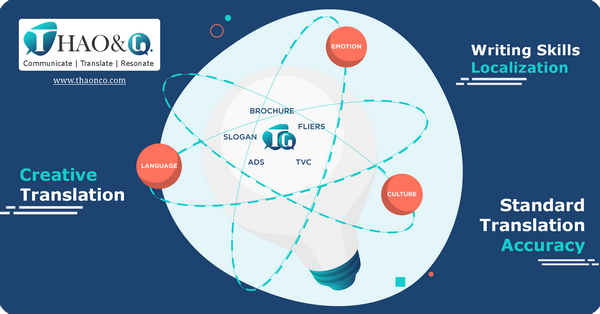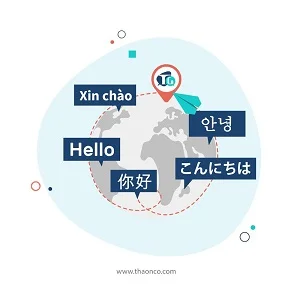Creative translation and standard translation may seem to have little difference at first glance. However, these two types of translation are applied to different specialized fields with their own specific characteristics. Without a clear understanding of the purpose and specific context, the translation cannot fully convey the intended message.
Creative translation (also known as transcreation) is a process of blending translation and creativity to adapt text from one language to another. The goal is to ensure that the target text maintains the context, tone, and emotions of the source text. Creative translation allows readers to experience the same emotions as when reading the original text.
Creative translation was initially used in the marketing industry. It properly conveys the emotions and the intended message of a business to the target audience in their native language.
Although both creative translation and standard translation involve reproducing the original text in the target language, transcreation is more commonly used for creative content such as song lyrics, literary works, film dialogues, advertisements, and other content in which the author’s emotions and implications should be precisely conveyed.
Translators must skillfully employ their lexical richness to preserve the inspiration of the original work. The process of transcreation recreates the tone and meaning of the source text while maintaining its nuances.

Transcreation and standard translation both aim to render a text into a different language while maintaining the original message. Standard translation starts with the source text, while transcreation begins with a creative brief. A translator is a medium, bridging translation and creativity.
Expert transcreators should have an excellent command of the requested language and a deep understanding of the spirit of the work. Translators can be creative in their word choices to convey the right tone and nature of the text.
Transcreation and standard translation may differ in terms of:
The type of translation required is determined by the specific field of the text to be translated. As the name suggests, creative translation is applied to fields that require creativity, such as literary works, poems, song lyrics, and advertising materials.
Art, or any other creative content, generally requires transcreating the original messages to evoke the same emotions and carry the same implications. Transcreation, therefore, can take invented words and give them the same impact in a different language.
The difference between creative translation and standard translation also lies in the writing skills of the translator. Transcreation calls for both translation and creative writing skills. Besides the knowledge in linguistics and relevant fields, writing skills can help linguists in their creative process without deviating significantly from the original.
Translators must have a firm grasp of creative translation methods and writing skills, as well as consider other aspects of the text to reproduce a natural and seamless transcreation in the same style and meaning as the original. Sometimes, they may even need to coin a new word to draw readers’ attention.
The creative translation must be adjusted to suit the cultural nuances and social norms of each country. In culturally diverse countries, there can be more freedom in language use. However, in cultures with certain beliefs, creative language should closely adhere to the context.
In addition, cultural factors are also evident in the differences among generations within each country. Older generations may find it difficult to understand the language of new generations. Creative translation requires the diversity and novelty in vocabulary to be frequently updated.

Creative translation and standard translation usually differ in terms of the semantic accuracy of the translation. Some types of translation such as: notarized translation, medical translation, legal translation, and technical translation require the text to be rendered with complete accuracy in meaning and terminology.
Transcreation conveys the same message and concept but with much more flexible language use. This avoids unnaturalness for the readers, while the impact of the words remains.
Another factor that determines the difference between transcreation and standard translation is the translation rate. Transcreation is generally a more complex process than translation, as it requires a flexible use of language while maintaining the essence of the original.
Transcreation is also delivered by expert translators of the relevant industry. Therefore, transcreation can be more costly than standard translation.
You can take a look at the differences between creative and standard translation discussed above to determine which one will be the best option for your text. It is also essential to consider the field and purpose of the text to make an appropriate choice.
Thao & Co. can help you get the most suitable type of translation for your project, as we provide a comprehensive creative translation service that meets your every need. Before translating, Thao & Co. takes a deep dive into the target market, language nuances, and cultural factors that can make a difference and provide suitable solutions for businesses.
Nowadays, many translation agencies provide transcreation, but not all creative translation services are created equal. Therefore, businesses looking for a translation agency may consider the following:
Thao & Co. offers creative translations that skillfully convey the message and tone of the original. Our team of professional transcreators, with extensive language expertise, is committed to helping businesses craft their messages with a creative flair that will catapult any campaign to success. Upon request, Thao & Co. will work with local market research agencies to conduct Customer Language Research before beginning the transcreation process to gain a thorough understanding of the target audience.

Depending on your industry and specific project requirements, Thao & Co. will compile a list of relevant vocabulary and terminology for the transcreation process. Our expert linguists skillfully adapt your messages to produce translations that resonate with your target audience while maintaining your unique brand identity.
Through this article, Thao & Co. aims to provide a brief overview of transcreation and the differences between transcreation and standard translation, which will hopefully help you decide on the best option for your creative translation project. If you have any further questions, please don’t hesitate to contact Thao & Co. on our Get a Quote page for assistance with creative translation service.